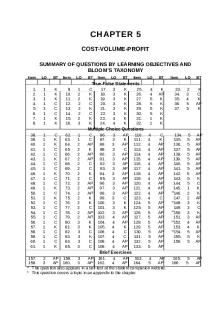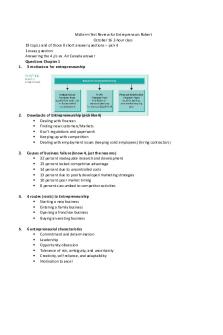Test Winter 2020, questions and answers PDF

| Title | Test Winter 2020, questions and answers |
|---|---|
| Course | Small Business and Entrepreneurship |
| Institution | Niagara College Canada |
| Pages | 5 |
| File Size | 199.6 KB |
| File Type | |
| Total Downloads | 87 |
| Total Views | 141 |
Summary
Robert Madronic...
Description
Midterm Test Review for Entrepreneurs Robert October 16 2-hour class 19 topics and of those 8 short answer questions – pick 4 1 essay question Answering the 4 p’s ex. Air Canada answer Questions Chapter 1 1. 3 motivators for entrepreneurship
2.
Drawbacks of Entrepreneurship (pick like 4) Dealing with finances Finding new customers/Markets Gov’t regulations and paperwork Keeping up with competition Dealing with employment issues (keeping solid employees) (hiring contractors)
3.
Causes of business failure (know 4, just the reasons) 32 percent inadequate research and development 23 percent lacked competitive advantage 14 percent due to uncontrolled costs 13 percent due to poorly developed marketing strategies 10 percent poor market timing 8 percent succumbed to competitor activities
4.
4 routes (roots) to Entrepreneurship Starting a new business Entering a family business Opening a franchise business Buying an existing business
5.
6 entrepreneurial characteristics Commitment and determination Leadership Opportunity obsession Tolerance of risk, ambiguity, and uncertainty Creativity, self-reliance, and adaptability Motivation to excel
1.
Chp 2 3 Startup ideas New Market o Providing customers with an existing product not available in their market New Technology o Involving new ideas, involving new technology, centred around providing customers with a new product New Benefit o Providing customers with an improved product
2.
General environment (or pestle)
3.
Factors contributing to competitive advantage Unique service features Price/value Notable product attributes Customer service Accessibility
4.
4 niche marketing strategies Restricting focus to a single market segment Limiting sales to a single geographical region Emphasizing a single product or service Concentrating on the superiority of the product
Chapter 4
1.
4 advantages of franchising Proven marketing concept and customer base o Use of an established, nation-wide brand Training o Help alleviate managerial weaknesses Financial assistance o Start-up business costs are high and by teaming up with a franchise, the individual can increase her/his chance of receiving financial help Operating assistance o Franchisor provides operating services, including site selection, bulk purchasing of equipment, and inventory
2.
Limitations of franchising Franchising Costs Restrictions -Initial franchise fee -Sales territory -Cash investment -Site approval required -Royalty payments -Outlet appearance -Advertising costs -Goods/services to be sold -Resale of franchise -Advertising and hours of operation
3.
5 legal issues Legal counsel must be obtained Consult a lawyer Discuss franchise proposal with a banker Seek a professional accounting firm Franchisee should be wary of contract provisions that contain
4.
4 reasons to buy an existing business To reduce uncertainties and unknowns Ongoing operations and relationships To obtain an ongoing business at a bargain price below what it would cost to start a new business To get into business more quickly than by starting from scratch
5.
Quantitative factors for evaluating a business Fair Value: Asset-based The value of a firm can be determined by estimating the value of its underlying assets. Market-based Relies on financial markets in estimating a firm’s value.
Earnings-based Firms value is determined by future returns from the investment. Cash flow-based Based on the amount and timing of its future cash flows 6.
1.
Qualitative reasons • Competition • Market • Future community development • Legal commitments • Union contracts • Buildings • Product prices Chp 6 3 marketing philosophies CONSUMER ORIENTED a. All marketing efforts begin and end with the customer b. Focus is on consumer’s needs c. Philosophy is most consistent with long-term success of firm PRODUCTION ORIENTED d. Emphasizes development of the product and production efficiencies over other activities SALES ORIENTED e. Favours product sales over production efficiencies and customer preferences
2.
4 segmentation variables Benefit Geographic Demographic Psychographic
3.
4 characteristics of services Tangibility Production/Consumption Standardization
Perishability
4. Building the total product offering (6 parts to it)
Service mark
Labelling
Packaging
Trademark
Branding
5.
PRODUCT
Warranties
8 pricing strategies (pick 4)
Bundling
Offering several products for one combined price.
Odd-Even
Make the price appear to be lower. Ending in 0.99.
Unit Pricing
Comparison where a product may be sold in different sizes.
Price Lining
Setting a range of several distinct merchandise levels.
Loss Leader
Products offered at or slightly below cost to attract people.
What the Market Will Bear
Charging as high a price as possible before resistance.
Marketing the 4 P’s – Product- The product the company is trying to sell the consumer. What product should we sell that consumers will want to purchase? Price- How much the company should charge for the product. Prices often go up or down depending on economy and competition. Price needs to be set based on materials manufacturing shipping etc. Place-The ‘home’ the product comes from, can be internet or a location Promotion- Product exposure and public relations. How you get your product out to the world....
Similar Free PDFs

Test 2020, questions and answers
- 30 Pages

Test 2020, questions and answers
- 22 Pages

Test 2020, questions and answers
- 6 Pages

TEST 5 2020, questions and answers
- 59 Pages

Test 5 2020, questions and answers
- 11 Pages
Popular Institutions
- Tinajero National High School - Annex
- Politeknik Caltex Riau
- Yokohama City University
- SGT University
- University of Al-Qadisiyah
- Divine Word College of Vigan
- Techniek College Rotterdam
- Universidade de Santiago
- Universiti Teknologi MARA Cawangan Johor Kampus Pasir Gudang
- Poltekkes Kemenkes Yogyakarta
- Baguio City National High School
- Colegio san marcos
- preparatoria uno
- Centro de Bachillerato Tecnológico Industrial y de Servicios No. 107
- Dalian Maritime University
- Quang Trung Secondary School
- Colegio Tecnológico en Informática
- Corporación Regional de Educación Superior
- Grupo CEDVA
- Dar Al Uloom University
- Centro de Estudios Preuniversitarios de la Universidad Nacional de Ingeniería
- 上智大学
- Aakash International School, Nuna Majara
- San Felipe Neri Catholic School
- Kang Chiao International School - New Taipei City
- Misamis Occidental National High School
- Institución Educativa Escuela Normal Juan Ladrilleros
- Kolehiyo ng Pantukan
- Batanes State College
- Instituto Continental
- Sekolah Menengah Kejuruan Kesehatan Kaltara (Tarakan)
- Colegio de La Inmaculada Concepcion - Cebu










